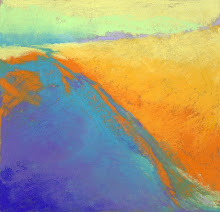 Late last fall I spent a day at Schoodic Point and was drawn to the cuts of ledge along the shore road (most people are drawn to the wild surf crashing against the rocks). When I got home I was eager to attack a canvas to express my experience. I had just started working with a galkyd mix medium which gives the paint an incredibly smooth fluidity. I went at it without intention of depicting reality. I worked fast, splashing paint around and I was very excited with where this took me (top). I immediately photographed it and sent it to my dear friend, painter, and respected art historian/teacher (she looks at art all day long) for her kind but honest critique. I knew there were parts unresolved but I was so in love with some of the passages that I didn't know what to do without ruining those precious parts. Here's what she said:
Late last fall I spent a day at Schoodic Point and was drawn to the cuts of ledge along the shore road (most people are drawn to the wild surf crashing against the rocks). When I got home I was eager to attack a canvas to express my experience. I had just started working with a galkyd mix medium which gives the paint an incredibly smooth fluidity. I went at it without intention of depicting reality. I worked fast, splashing paint around and I was very excited with where this took me (top). I immediately photographed it and sent it to my dear friend, painter, and respected art historian/teacher (she looks at art all day long) for her kind but honest critique. I knew there were parts unresolved but I was so in love with some of the passages that I didn't know what to do without ruining those precious parts. Here's what she said: "Wow - great start! I do agree with you that you need some further work at the botton left. I also think you need to resolve the central portion. Remember that I am just viewing a digital shadow of the actual work, but to me, there is a mushy kind of disconnect between the blue/grey foreground and what is going on in the middle and deep distance. Now if you are going for abstraction that is not an issue, and I also think even so the composition reads as top central triangle of blue/pink, slashes of yellowy green meeting in the center and more structured block like forms at the base. I think you could firm up the composition to get a stronger sense of form no matter which way you are heading with this. As it stands now to me, everything is falling off to the left and I am just longing to get a sense of structure. Does any of this make sense to you?Maybe if you counter the dominant stretch of yellowy green running in from the left downwards with something to pull the energy back into the work?"
Hmmm. My heart sank but I knew she was right. Lack of structure in my work is the biggest criticism I get and something I always struggle with, being so involved in color. But I didn't want to touch it. I didn't want to lose the fluidity, the spontaneity. But I've also been told by many a teacher and mentor to NOT get attached to parts of a painting and try to work around them. It never works, and I have confirmed that before. So, I let the painting sit for many weeks. I looked at it frequently but separated myself emotionally from what excited me about it. One day, I just knew what it needed and launched in as though it was a whole new painting. (bottom) There is very little of what I loved about the original left, but it is a far superior painting. And I like it more than the original stab. This is what my friend said: "Oh! Divine, dreamy marvelous beautiful!"
Moral of the story: don't let anything about painting become precious and untouchable.
Finished painting: On the Rocks, 14 X 18, oil on canvas panel










